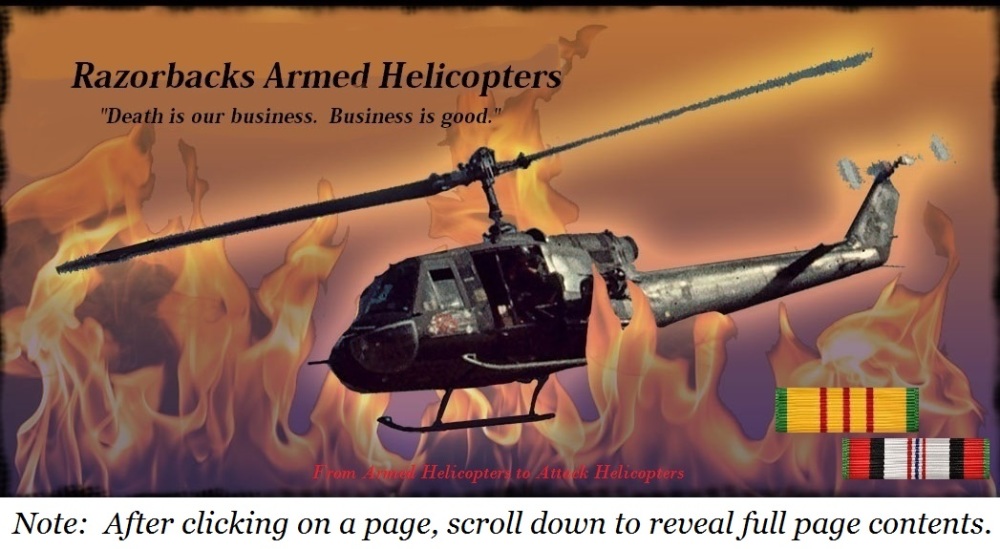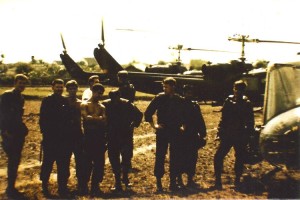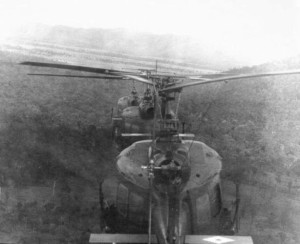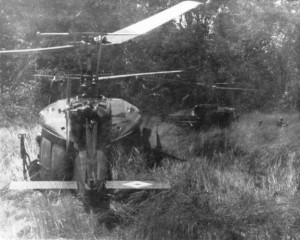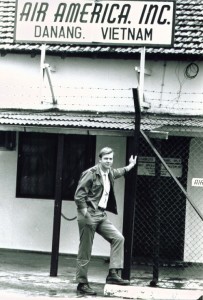The second of “37’s” remembrances
More Pigs in Saigon
In a rice paddy after the crash
This photo shows the Razorback crews after a tail rotor failure put one aircraft impaled on a barbed wire metal stake. What happened: the lead aircraft said he was experiencing some odd things happening and elected to land at Muc Hoa, a small runway with refuelling and rearming facilities. He was all right until his airspeed got below 40 knots and the aircraft began to spin on final approach. He cut the throttle and ended up crashing the helicopter on the camp perimeter wire. An iron stake went through the fuel tank. Our aircraft landed 50 meters away and by the time I got there, the crew had gone but the engine was still running in idle. I turned to get back to my own aircraft and noticed a set of prongs sticking out of the ground. It dawned on me that we had landed in a mine field. I yelled to my crewman to look where he was stepping and we lifted straight up and landed in the rice field on the outside of the perimeter. The 30 minute team showed up shortly to get in the photo.
The sniffer mission was done just before dusk or right after dawn for two reasons. First, the wind was usually still and two, people were either making dinner, breakfast, or having a smoke. It had nothing to do with sniffing out urine like was thought. In the helicopter was a box that counted condensation nuclei, dust particles to us common folk. When people make food, smoke a cigarette, or a group of men walking in the jungle they raises dust. A black box counted the density of the particles and the location was registered on a map. The operation used three helicopters; the sniffer, one gunship low and behind, and the last high doing the navigating and marking the hot spots. Later, these spots might be hit with artillery or a long range patrol sent in to check out enemy activity. But again, it could have been an active troop of monkeys or the odd elephant making the dust.
I can remember two of the many sniffer missions we did. West of Saigon was a flat plain of reeds crossed with canals which were made by French engineers many years ago to irrigate the rice fields. We were flying low level, about 50 feet, when I saw people in the grass! There was no reaction from the sniffer. We pulled up and called to find out if they were the South Vietnamese, no they weren’t and we got clearance to fire. We expended everything and then called for artillery. They sent in some South Vietnamese troops to clean up and claimed the body count.
Even flying a gunship can get a little boring sometimes, so I tried flying with another company that did troop insertions for a day. I wanted to get some photos. I was getting some good shots but on short final to the landing zone the commander told me to put the camera down and pay attention in case he got shot. As it turned out we took no fire and I have some of the best photos I took in Vietnam.
These two photos are taken with a 135 mm lens. This makes the aircraft in the first photo appear to be flying almost on top of one another. Actually, the aircraft are not more than one rotor disc away, the normal distance for flying formation in the army at that time. The vertical separation is maintained by keeping the tail rotor gearbox in line with the exhaust pipe. It becomes second nature after a while. The other photo shows the rotor blades coning after using most of the power available due to the load and landing in tall grass destroys most of the ground effect.
The heliport had a lot of activity. Not only were the normal flights of helicopter coming and going, the gunships re-positioning to the stand-by area, but there was a number of movements by CH-47s (Chinook) and CH-64s (Sikorsky Sky Cranes). Most of the Chinook flights came to pick up jeeps, had been stolen. The Chinook would land and one Jeep would drive out, an hour or so later three Jeeps would drive in and the Chinook would waste no time in leaving. The Sky Cranes would bring in aircraft to the heliport and be taken over to a near-by facility where they were packed in plastic and shipped to the US for overhaul or storage. What is hard to appreciate here is the small size of the heliport, the obstacles surrounding the area, and the number of movement of aircraft.
I had the unfortunate luck of having FOD (foreign object damage) to the compressor while taking off from the heliport. I narrowly missed coming down in the liqueur sales part of the PX. I also missed all of the antennas and wires on the other side of the building and landed in the mud. The general officer I had on board took his shoes off and waded to dry land. The maintenance officer tried later to fly it out but just managed to get further into it.
My other recollection of flying the sniffer was when I had transferred to a Cobra unit at Ben Hoa, this time it was Charley’s turn to give me something to think about. We had finished sniffing the areas we had been assigned that morning and were asked to sniff a square kilometer south and west of Long Than, not that far from the Main Headquarters at Long Bin. I had two Cobras behind me, one low and the high one leading me to the area. We were on the first pass when I saw the fire coming out of a tree line through the right window. I made a sharp turn to the left and a second later the aircraft shook, we were hit. The instruments were gone, but we were still in the air and getting the hell out of there. We landed at Long Than and looked for the bullet hole on the right side but found none. We finally found it on the left side. It had come in along the belly of the aircraft, under the cargo door. It had followed along the fuel tank leaving a brown burn mark without puncturing the tank. It had come in at an angle such that it had pushed the honeycomb aluminium until it hit the wire bundle and the main spar, then stopped. This had caused the instruments to malfunction. But there was a question of the damage being on the left side of the helicopter. I saw the gun on the right? The only explanation I can give is that the helicopter was over a 90 degree bank angle or there was another machine gun that hit me. This was 23 days before I was to leave Vietnam and the army. I made a lot of dentist appointments and stayed away from the company area. I took up watching baseball at my buddy’s hooch in Long Binh. They did catch me a couple of times to fly, but never again on the sniffer.
I left the army in January 1970 and started looking for a job. I had been a pilot for two and a half years and had a little over 1600 hours. Adjusting to civilian life was harder, drinking was a big problem and the welcome home for veterans was pretty cold. My mother told me after a while, sort of joking, that she liked it better when I was in Vietnam, at least she knew where I was at night. She almost always waited up for me to come home.
